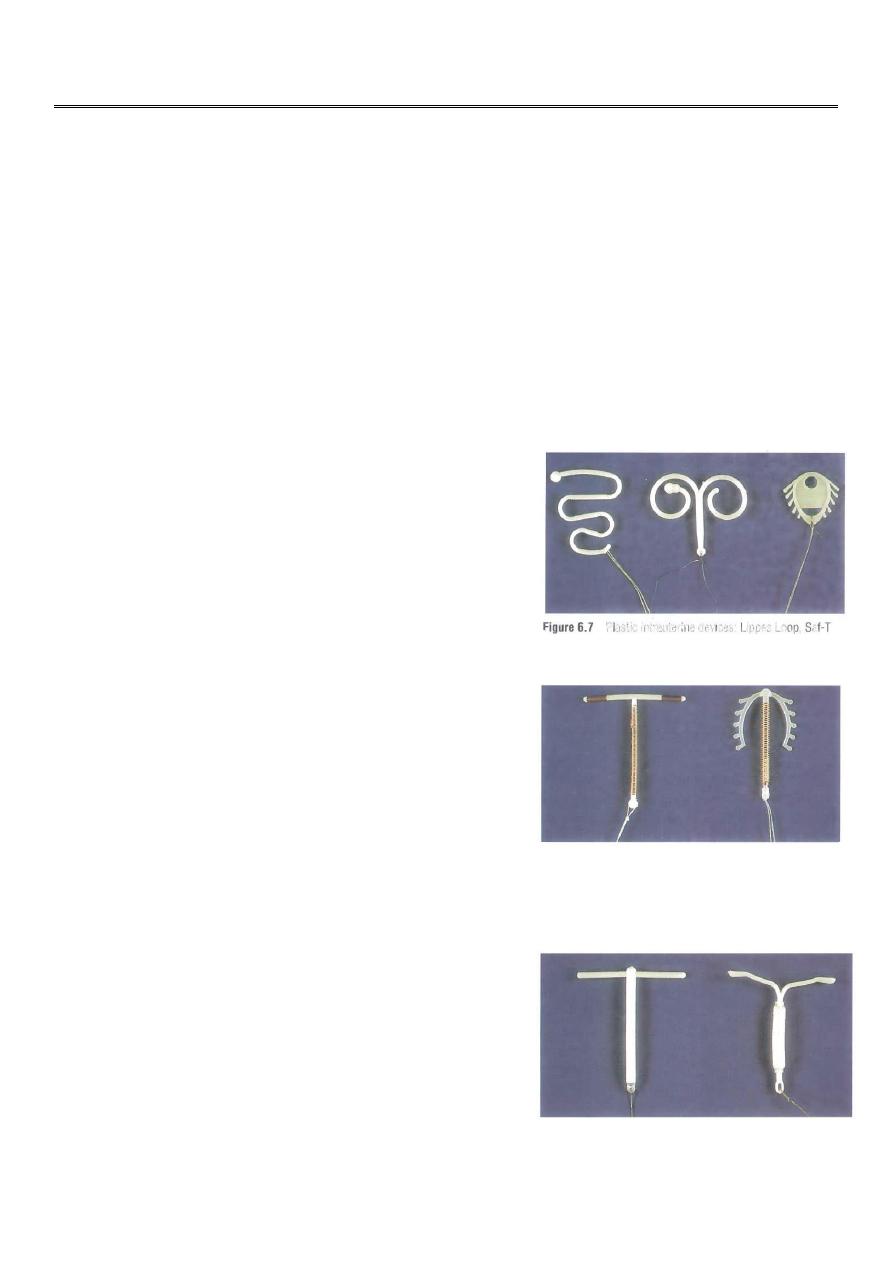
1
Gynecology
.د
سجى
Lec-3
Intrauterine contraception device
An IUD is ideal for women who want along-term method of contraception and where
regular compliance is not required.
IUDs protect against both intrauterine and ectopic pregnancy, but if pregnancy occurs,
there is a higher chance than normal that it will be ectopic
Types
1-plastic inert devices
(Lippes Loop or Saf-T coil), which often caused
significantly heavier and more painful menstrual
periods ,These are no longer available, although some
women may still have them in situ. Once fitted, they
could be left until the menopause.
2-copperbearing IUD
which are available in various shapes and sizes They
cause much less_menstrual
disruption than the older plastic devices.
Most copper-bearing IUDs are licensed for between 3
and 5 years of use, but many will last longer, possibly
up to 10 years. The more copper wire a device has, the
more effective it is
3-Hormone-releasing devices [mirena]
have also been developed The levonorgestrel-
releasing in trauterinesystem (IUS) has the advantages
(and disadvantages) of both hormonal and
intrauterine contraception (Table 6.5 ).
It is associated with a dramatic reduction in menstrual
blood loss and is licensed for contraception and the
treatment of menorrhagia

2
Mode of action
1-All IUDs induce an inflammatory response in the endometrium which prevents
implantation. However,
2-copper-bearing IUDs work primarily by a toxic effect on sperm which prevents
fertilization.
3-The mirena IUS prevents pregnancy primarily by a local hormonal effect on the cervical
mucus and endometrium
Contraindications
• Previous PID.
• Previous ectopic pregnancy.
• Known malformation of the uterus.
• Copper allergy (but could use an IUS).
*abnormal uterine bleeding
*nulliparity
Side effects
1-Menstrual disturbance:menorrhagia & 2ry dysmenorrhea may occur .
2-Expulsion: This is most likely to occur in the first year which may occur sometime without
noticing
3-Perforation: Occur at time of insertion in 1.3 /1000 insertions.
Routine follow–up 6 weeks after insertion allows most perforations to be detected.
4-Increased risk of pelvic infection in the first few weeks following insertion
Although IUDs increase the risk of PID in the first few weeks after insertion, the long-
term risk is similar to that of women who are not using any method of contraception
5-pregnancy :if failure occur there is high incidence that pregnancy is ectopic.if intrauterine
pregnancy occur there is more risk of abortion ,preterm labour & antepartum hemorrhage
Insertion
It is better to be inerted in the first even days of menstrual bleeding so there is no
pregnancy & the cervix is soft

3
The cervix is exposed with speculum,Uterine sound is usedto measure length of uterine
cavity.
The introducer is inserted and the IUD expelled into the cavity then its thread is cut short
Natural family planning
This is an extremely important method of contraception worldwide and may e the only one
acceptable to some couples for cultural and religious reasons.
It involves abstaining from intercourse during the fertile period of the month
The failure rates of natural methods of family planning are quite high
The fertile period is calculated by various techniques
such as:
• changes in basal body temperature,
• changes in cervical mucus,
• changes in the cervix,
• multiple indices, many types of kits available
The lactatinal amenorrhoea method[LAM]
it has failure rate of 2% if:
*Women who are fully breast – feeding especially at night.
*she is amenorrhoeic.
*during the first 6 months after child birth.
Barrier methods of contraception
Condoms
Male condoms are usually made of latex rubber. They are cheap and are widely available .
They have been heavily promoted in prevention of the spread of sexually
transmitted diseases (STDs), particularly human immunodeficiency virus (HN) and acquired
immunodeficiency syndrome (AIDS

4
Female barriers
The diaphragm& cap, are the female barriers They should all be used in conjunction with a
spermicidal cream or gel.
The effective use of a diaphragm requires careful teaching and fitting.
Female barriers offer protection against ascending pelvic infection but can increase the risk
of urinary tract infection and vaginal irritation
Female condoms made of plastic are also available Spermicidal agents should not be used
as a contraceptive method on their own: their main role is to make barrier methods more
effective
Coitus interruptus
Coitus interruptus, or withdrawal, is widely practiced and obviously does not require any
medical supervision.
Unfortunately, it is not reliable, as pre-ejaculatory secretions may contain millions of sperm
and young men often find it hard to judge the timing of withdrawal
